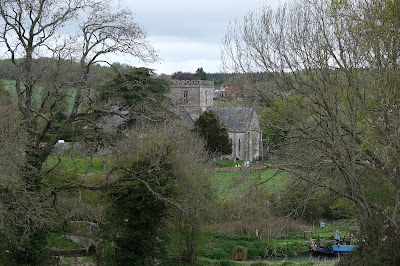We climbed a grassy path away from the Castle and soon had this delightful view behind us.
We followed Knowle Hill along a hill top with a valley to the left and the coast in the distance.
After a while we could make out Church Knowle in the valley to our left and managed to find the right path to take us down into the main (almost only) street of Church Knowle. We had a most enjoyable meal and a good chat with our friends and then walked along the street to the church of St Peter.
It dates from the early 13th century. The west tower with its pyramid roof was rebuilt in 1741.
We turned right here and followed a narrow road past a few houses to a track when led us across a grassy area to reach to almost hidden Corfe River. We followed the stream in the direction of Corfe, with the tower of the church at Kingston (the work of the great Victorian architect G E Street) visible on its high point.
We passed an intriguing group of buildings on our left, West Bucknowle House ...
... and gradually moved away from the stream. Soon there was a fine view of the long ridge that runs from Corfe down towards Swanage. It is a really fine walk which we have done a couple of times.
Now the Castle came into view again, but from a viewpoint previously unknown to us. Its natural defensive characteristics are more clear than from any other angle.
This was even more the case as we got nearer.
Having skirted the castle at some distance we entered the village passing the large church of St Edward, King and Martyr (a church dedication I have never previously heard of). It is by T H Wyatt and dates from 1859-60.
Just beyond the church is the Town Hall of 1774. It claims to be the smallest Town Hall in the country.
Not long after this we passed the entrance to the castle and walked down the hill to retrieve our car from the car park.
Conditions: bright and sunny.
Distance: about 4 miles.
Map: OL 15 (Purbeck and South Dorset)
Rating: four stars.




















